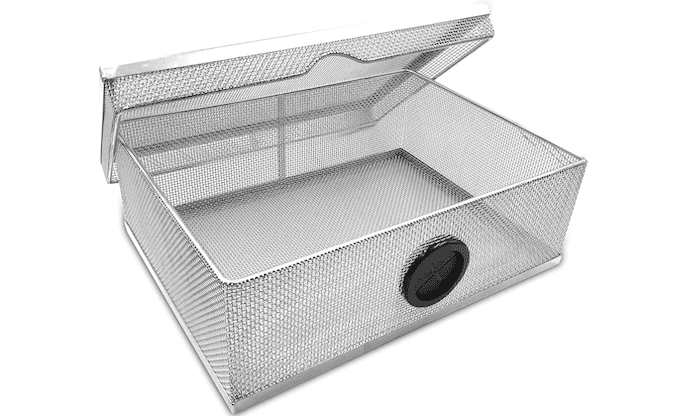Ever wondered how to make a WiFi router guard? In today’s digital world, protecting yourself from EMF radiation is not just smart; it’s essential. This article dives into the world of WiFi router guards, your shield against unwanted exposure. We’ll guide you through creating one, ensuring your peace of mind and health.
Wrap your router in a conductive material, like metal mesh or Faraday fabric, ensuring openings allow for signal reach and cable access.
Discover simple steps and materials to safeguard your space effectively. Let’s get started!
Contents
Tips to Prepare to Make Your Router Guard
Let’s start with gathering materials and other preparations to make your Router guard:
Materials and Tools Needed
To start, gather these materials:
- Conductive Metal Mesh or Aluminum Foil: These block EMF radiation.
- Copper Tape or TitanRF Faraday Fabric: Enhances shielding.
- Scissors and Glue: For cutting and assembling.
- Measuring Tape: Ensures accurate sizing.
- Safety Equipment: Gloves and protective eyewear are crucial.
Safety Precautions and Considerations
Safety first! When handling conductive materials and tools, wear gloves and protective eyewear. Measure your router to choose the right size and type of guard. Based on your router’s design, decide between a cage or a fabric pouch.
Choose the Right Materials
Select materials based on your router’s size and shape. Metal mesh is great for standard routers, while Faraday fabric suits larger or oddly shaped ones.
Tools for the Job
Ensure you have sharp scissors for cutting materials and a reliable glue for assembly. A measuring tape is essential for accurate sizing.
Safety Measures
Always prioritize safety. Wear gloves to avoid cuts and protective eyewear to shield your eyes from any debris.
Measure Your Router
Accurately measure your router to ensure your guard fits well. Consider the size and shape of your router when choosing between a cage or fabric pouch.
Gathering the right materials and tools is the first step in creating an effective WiFi router guard. Prioritize safety and accuracy for a successful DIY project.
DIY WiFi Router Guard Projects
Following are some of the WiFi Router guard projects:
Router Guard with Metal Mesh
Follow this step-by-step guide to make a Router Guard with Metal mesh.
Materials Required
- Conductive metal mesh or aluminum window screen
- Scissors
- Glue or tape
- Measuring tape
How to Make a Router Guard with Metal Mesh
- Measure Your Router: Use the measuring tape to determine the dimensions of your router. Add a few extra inches to each side for adequate coverage.
- Cut the Metal Mesh: Cut the metal mesh using scissors to the size you’ve measured. Be sure to wear gloves to avoid any sharp edges.
- Form the Guard: Wrap the cut mesh around your router, forming a cage-like structure. Ensure there are openings for cables and ventilation.
- Secure the Edges: Use glue or tape to secure the edges of the mesh, ensuring the guard stays in place.
- Test Signal Leakage: Place the guard over your router and check for enough signal leakage for proper functionality. Adjust as needed.
Tips to Make Router Guard with Metal Mesh
- Ensure the guard allows for proper ventilation to prevent overheating.
- Test your WiFi signal strength before and after to ensure the guard doesn’t overly restrict connectivity.
Fabric Router Guard (Signal Tamer)
Follow this step-by-step guide to make a Fabric Router Guard:
Materials Required
- Shielding fabric (e.g., TitanRF Faraday Fabric)
- Scissors
- Sewing kit or fabric glue
- Measuring tape
How to make a Fabric Router Guard
- Measure Your Router: Determine the dimensions of your router, adding extra inches for full coverage.
- Cut the Fabric: Use scissors to cut the shielding fabric to the size you’ve measured.
- Sew or Glue the Edges: Create a pouch by sewing or gluing the edges of the fabric. Leave one side open for the router to slide in.
- Insert the Router: Slide your router into the fabric pouch, ensuring it’s fully covered.
- Test Connectivity: Check your WiFi signal strength to ensure the fabric guard reduces EMF radiation without significantly affecting connectivity.
Tips to Make a Fabric Router Guard
- Choose a fabric that’s easy to work with and provides adequate RF shielding.
- Regularly check the fabric guard for wear and tear and replace it as needed.
Faraday Fabric Router Bag
Here is everything you need to gather and the steps to make a Faraday Fabric Router Bag
Materials Required
- TitanRF Faraday Fabric
- TitanRF Faraday Tape
- Scissors
- Sewing kit or fabric glue
- Measuring tape
How to make Faraday Fabric Router Bag
- Measure Your Router: Get the dimensions of your router, adding extra inches for a comfortable fit.
- Cut the Fabric: Use scissors to cut the Faraday fabric according to your measurements.
- Form the Bag: Sew or glue the edges of the fabric to create a bag, leaving the top open for the router.
- Seal with Tape: Use TitanRF Faraday Tape to seal the open top when the router is inside, ensuring complete coverage.
- Test EMF Reduction: Check the effectiveness of your router bag in reducing EMF radiation while maintaining WiFi connectivity.
Tips to Make Faraday Fabric Router Bag
- Ensure the bag is not too tight, allowing for easy insertion and removal of the router.
- Regularly inspect the bag and tape for any damage or wear.
Advanced DIY EMF Shielding Projects
For those looking to take their EMF protection to the next level, here are some advanced DIY projects:
Whole-Room EMF Shielding
- Materials: EMF shielding paint, EMF shielding fabric, grounding tape.
- Steps: Paint walls with EMF shielding paint. Cover windows with EMF shielding fabric. Use grounding tape to connect the fabric to an electrical ground.
EMF Shielding Bed Canopy
- Materials: EMF shielding fabric, canopy frame, grounding kit.
- Steps: Drape EMF shielding fabric over the canopy frame. Ground the fabric for extra protection.
Personal EMF Shielding Clothing
- Materials: EMF shielding fabric, sewing kit, clothing pattern.
- Steps: Choose a clothing pattern (e.g., hoodie, hat). Cut and sew the EMF shielding fabric according to the pattern.
Tips to Make DIY EMF Shielding Projects
- Test Regularly: Use an EMF meter to test the effectiveness of your shielding.
- Grounding: Proper grounding is crucial for some advanced projects, reducing the risk of electric shocks.
- Maintenance: Check your shielding solutions regularly for wear and tear.
By incorporating these advanced DIY EMF shielding projects into your home, you can create a safer and healthier living environment, minimizing exposure to harmful electromagnetic radiation.
FAQs
Can a WiFi router guard affect internet speed?
A well-designed router guard made of materials like metal mesh or Faraday fabric can reduce EMF radiation without significantly affecting internet speed or connectivity.
How does a router guard protect against EMF radiation?
Router guards act like a Faraday cage, blocking or attenuating EMF radiation while allowing enough WiFi signal to pass through for continued functionality.
What materials are adequate for DIY router guards?
Conductive materials such as aluminum foil, copper tape, and TitanRF Faraday Fabric are effective for DIY projects aimed at EMF protection and RF shielding.
How can I test the effectiveness of my DIY router guard?
You can use an EMF meter to measure radiation levels before and after installing the guard. A noticeable reduction in EMF readings indicates effectiveness.
Is it necessary to ground a DIY router guard?
Grounding is not typically required for router guards, as they are designed to attenuate radiation rather than completely block it. However, for advanced EMF shielding projects, grounding may enhance effectiveness.
Conclusion
In summary, reducing EMF exposure is crucial for your health and well-being. With the DIY projects outlined in this article, you can easily create effective WiFi router guards and advanced EMF shielding solutions. Whether you opt for a simple metal mesh guard or a more advanced Faraday fabric bag, balancing EMF reduction with maintaining WiFi connectivity is key. Regular testing and maintenance are essential to ensure your DIY solutions remain effective.

Srivatsa is a prolific writer who spearheads the core writing team on tech news, buying guides, reviews, and all gadget articles. He is passionate about technology.
